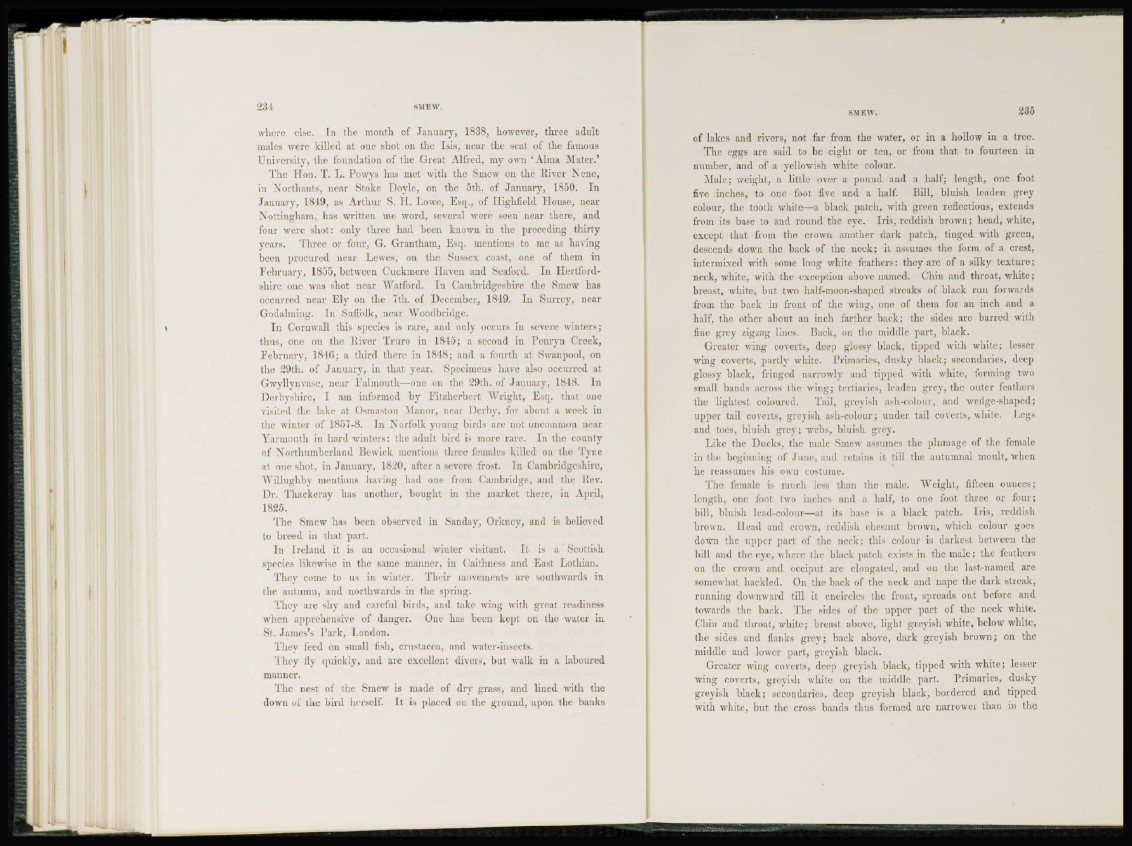
SMEW .
where else. In the mouth of January, 1838, however, three adult
male- were killed at one shot on the Isis, near the seat of the famous
University, the foundation of the Great Alfred, my own 'Alma Mater.'
The Hon. T. L. Powys has met with the Smew on the River Nene,
in Northants, near Stoke Doyle, on the 5th. of January, 1850. In
January, 1819, as Arthur S. I I . Lowe, Esq., of Ilighfield House, near
Nottingham, has written me word, several were seen near there, and
four were shot: only three had been known in the preceding thirty
years. Three or four, G. Grantham, Esq. mentions to me as having
been procured near Lewes, on the Sussex coast, one of them in
February, 1855, between Cuckmere Haven and Seaford. In Hertfordshire
one was shot near Watford. In Cambridgeshire the Smew has
occurred near Ely on the 7th. of December, 1849. In Surrey, near
Godalming. In Suffolk, near Woodbridge.
I n Cornwall this species is rare, and only occurs in severe winters;
thus, one on the River Truro in 1845; a second in Penryn Creek,
February, 1846; a third there in 1848; and a fourth at Swanpool, on
the 29th. of January, in that year. Specimens have also occurred at
Gwyllyuvase, near Falmouth—one on the 29th. of January, 1848. In
Derbyshire, I am informed by Fitzherbert "Wright, Esq. that one
visited the lake at Osmaston Manor, near Derby, for about a week in
the winter of 1857-8. In Norfolk young birds are not uncommon near
Yarmouth in hard winters: the adult bird is more rare. In the county
of Northumberland Bewick mentions three females killed on the Tyue
at one shot, in January, 1820, after a severe frost. In Cambridgeshire,
Willughbv mentions having had one from Cambridge, and the Rev.
Dr. Thackeray has another, bought in the market there, in April,
1825.
The Smew has been observed in Sanday, Orkney, and is believed
to breed in that part.
l u Ireland it is an occasional winter visitant. It is a Scottish
species likewise in the same manner, in Caithness and East Lothian.
They come to us in winter. Their movements arc southwards in
the autumn, and northwards in the spring.
They are shy and careful birds, and take wing with great readiness
when apprehensive of danger. One has been kept on the water in
St. James's Bark, London.
They feed on small fish, Crustacea, and water-insects.
They fly quickly, and are excellent divers, but walk in a laboured
manner.
The nest of the Smew is made of dry grass, and lined with the
down of the bird herself. It is placed on the ground, upon the banks
KM F , \ V. 235
of lakes and rivers, not far from the water, or in a hollow in a tree.
The eggs are said to be eight or ten, or from that to fourteen in
number, and of a yellowish white colour.
Male; weight, a little over a pound and a half; length, one foot
five inches, to one foot five and a half. Bill, bluish leaden grey
colour, the tooth white—a black patch, with green reflections, extends
from its base to and round the eye. Iris, reddish brown; head, white,
except that from the crown another dark patch, tinged with green,
descends down the back of the neck; it assumes the form of a crest,
intermixed with some long white feathers: they are of a silkv texture;
neck, white, with the exception above named. Chin and throat, wdiite;
breast, white, but two half-moon-shaped streaks of black run forwards
from the back in front of the wing, one of them for an inch and a
half, the other about an inch farther back; the sides are barred with
fine grey zigzag lines. Back, on the middle part, black.
Greater wing coverts, deep glossy black, tipped with white; lesser
wing coverts, partly white. Primaries, dusky black; secondaries, deep
glossy black, fringed narrowly and tipped with white, forming two
small bands across the wing; tertiaries, leaden grey, the outer feathers
the lightest coloured. Tail, greyish ash-colour, and wedge-shaped ;
upper tail coverts, greyish ash-colour; under tail coverts, white. Legs
and toes, bluish grey; webs, bluish grey.
Like the Ducks, the male Smew assumes the plumage of the female
in the beginning of June, and retains it till the autumnal moult, when
he réassumes his own costume.
The female is much less than the male. Weight, fifteen ounces ;
length, one foot (wo inches and a half, to one foot three or four;
bill, bluish lead-colour—at, its base is a black patch. Iris, reddish
brown. Head and crown, reddish chesnut brown, which colour goes
down the upper part of the neck; this colour is darkest between the
bill ami the eye, where the black patch exists in the male; the feathers
on the crown and occiput are elongated, and on the last-named are
somewhat hackled. On the back of the neck and nape the dark streak,
running downward till it encircles the front, spreads out before and
towards the back. Tin; sides of the upper part of the neck white.
Chin and throat, wdiite; breast above, light greyish white, below white,
the sides and flanks grey; back above, dark greyish brown; on the
middle and lower part, greyish black.
Greater wing coverts, dec]) greyish black, tipped with white; lesser
wing coverts, greyish white on the middle part. Primaries, dusky
greyish black; secondaries, deep greyish black, bordered and tipped
with white, but the cross bands thus formed are narrower than in the